In order to tackle the climate crisis, the greening of the district is one of the top priorities of Budapest Metropolitan Area 6th district Terézváros Municipality. Especially during the pandemia the community garden has been the key element of our sustainability projects. Although community gardens have become increasingly popular in Budapest recently, in historic urban settings it is difficult to find a place for such initiatives, as the number of empty plots is extremely limited.
Rózsa-kert, the community garden of Budapest Metropolitan Area 6th District Terézváros opened in June 2021. In the garden there are 32 high beds with a surface area of 4m2 each, where gardeners grow vegetables, herbs and flowers. The plot has been vacant for years. There were 80 applicants for the beds, the municipality formed groups according to social status (families with children, disadvantaged people, pensioners, etc.), and then drawn by lot.
Initially the municipality planned to build social housing and a pulmonology care centre on the lot, however due to the conciliation process taking up years, on the initiative of deputy mayor Szilvia Temesvári the municipality decided to open a temporary community garden, the first in the district of Terézváros called Rózsa-kert, in June 2021.
The owner of the community garden is Budapest Metropolitan Area 6th district Terézváros Municipality. The plot has a surface area of 850m2. There used to be a building, which was demolished years ago. The new municipality management elected in 2019 decided in 2021 to make a living, green surface, a community garden and a small park in the densely inhabited 6th district of Budapest, with several functions. Part of it can be a pleasant, urban setting for community events related to environmental protection, health preservation, education and community culture. The vision of the new municipality management is a greener, more liveable inner city, where the adaptation of the residents to climate change is helped and a green island was created in the densely populated inner city district where the green surface are per head is the second lowest in Budapest.
The professional partner of the municipality in the operation of the garden and community organization is the Contemporary Architecture Centre (Kortárs Építészeti Központ (KÉK)). The foundation shares knowledge with the community gardeners and the greater public at events in the community garden which enables them to co
Please highlight how the project can be exemplary in this context
Making a community garden in the inner city of Budapest is a sustainable initiative in itself, as in the middle of the city it provides an example easy to follow how to change your attitude and become more environmentally conscious. It calls the attention in itself to the necessity of paradigm change. This municipality project is unique and timely because it provides a new aspect of space use in the city, to reinvent urban spaces, the manifestation of sustainable education and to implement know-how in practice.
Gardeners, supported by a professional organization improve water saving in the garden by using mulch, watering consciously and improving the quality of the soil (e.g. by using fungal compost). They produce crops without using chemicals, and try to improve the green surface area consciously, besides using elevated beds they also wish to make a vertical garden. The gardeners made a birdbath from waste tiles, and planted bee-friendly flowers in the beds (e.g. facelia) to promote biodiversity. The gardeners try to keep the garden plastic-free.
Locally generated green waste is composted locally, thus organic material can be recycled in the high beds in a year. On certain days the residents of the district can also bring their green waste into the compost. The gardeners keep a voluntary compost master roster, where they supervise what is put in the compost and give advice if needed. In addition, composting courses are organized for the residents of the district so that they collect their green waste separately.
Similarly to other community gardens, Rózsa-kert has become an urban space to grow food. As a result of globalization, the relationship of the city to rural areas has disintegrated, and cities of today rely on international food supply chains. Therefore urban food production has become important. Of course, vegetables grown in a community garden on a vacant lot cannot be sufficient to cover the needs of the gardeners of Rózsa-kert, however commu
Please highlight how the project can be exemplary in this context
The bigger part of the 850 m2 municipality-owned plot at Rózsa utca 51-53 is occupied by the community garden, while the other part hosts a little park with flowerbeds and where we are planning to make a “nature trail”, providing information about the plants there. The park is cultivated by the gardeners of the municipality, providing an asthetic experience for visitors and passers-by. Around the high beds there are planters with trees and also beds for joint cultivation. The park was created shortly after the community garden had been opened, with benches, tables and flowerbeds maintained by the gardeners of the municipality.
For the gardeners it is a wonderful experience that they can contribute as individuals to the improvement of their environment. A key role of community gardens is to connect empty, unused spaces to urban life, providing a new, aesthetic layer for the urban setting while increasing the area of green surfaces in the city.
The Rózsa-kert community garden is a unique element of the city landscape, as its visual looks are significantly different from traditional construction types, it is a highly visible, open area. An area, which improves the attractiveness of the city, which is especially important in a densely populated area such as the district of Terézváros, a significant part of which is a UNESCO World Heritage site. The looks of the plot has been improved a lot by the creation of flowerbeds and the neatly arranged high beds full of vegetables.
For a clear picture about the aesthetics of the Rózsa-kert, please watch this short video (in Hungarian language) about it:
https://www.youtube.com/watch?v=iNSLbxwDJos&ab_channel=Ter%C3%A9zv%C3%A1ros
Please highlight how the project can be exemplary in this context
The new management of the municipality, elected in 2019 decided in 2021 to create a living, green surface, a community garden and a little park in the district, providing for multiple functions, acting as a site for community events, environmental protection, health preservation, education and community culture. The vision of the new district management put special emphasis on greening the area and increase citizen participation, so that new friendships and communities can be formed, and the residents of the district of Terézváros can get to know each other better.
With regard to organization, Rózsa-kert is a top-down community garden established by the municipality. However, by the second year of its operation, self-organization has also become apparent - the gardeners have elected a three-member board to manage the garden in the beginning 2022. Communication and decision-making is done by a mailing group, and this is especially important in winter when work in the garden is scarce. One bed was given to the employees of the municipality, which is very good for their recreation, and also a connection can be established between municipality employees and the residents.
Although in the garden there are plots only for 32 gardeners, and fluctuation is low, the municipality tried to provide plots for various social groups according to various aspects (proximity, age, children, motivation), of which the applicants were drawn by lot. The gardeners received to plots for an indefinite period, and only have to pay a very small sum as a contribution. Decisions are made jointly in person and on the mailing list.
Although actual gardening is accessible for relatively few people because of the limited number of plots, anybody can bring their green waste to the compost in the garden at regular intervals, from March to November. The compost made here will be used in the garden and the park, and this way any citizen can become part of the community garden.
Please highlight how this approach can be exemplary
Community gardening can only be successful if participants do not only acquire knowledge about healthy vegetable growing, but also develop as a community, and learn how to cooperate. They must take into consideration the plots of the others as well, for instance when planting anything they have to consider not to shade the plots of others. When planning the bed and the crops they must take into consideration the position of the Sun, as higher crops may shade the crops of the other gardeners. Plants not cultivated properly may be infectious for the plants of the others, therefore proper communication between the gardeners is essential.
When the community garden was established, the municipality tried to organize people of various age and background into one community, to try out small-scale food sovereignty. The skills acquired jointly, in the course of ecological gardening and their changed attitude can be used in other areas of life as well. From this year we would like to organize more events (which was unfortunately prevented by the pandemic last year) so that the space can really become a community park.
The Municipality started the community garden project in July 2021, when because of the pandemic people had to avoid closed spaces and the number of events they used to frequent earlier decreased significantly. In this situation community gardening and the creation of the small park provided a unique opportunity for relaxation, chilling out and acquire a new attitude.
Success is mostly shown by the popularity of the garden, which is shown by the continuous flow of new applicants. By now, the gardeners have chosen a board, and started working as a democratic, live community. They organize community events where they make pallet furniture in the garden together, acquire new skills, or make a roster for the compost master task. An activist street artist also got involved in the project, creating a piece of art related to climate change together with the community, and then placed in the garden. Art is a perfect tool to raise awareness concerning climate change.
According to a recent survey, the gardeners of the Rózsa-kert community joined the community garden for the following reasons:
- environmental protection, sustainable lifestyles - 87%
- useful spare time activity, joining a good cause - 74%
- getting healthier food from a known source - 58%
- getting to know others with similar interests - 48%
- getting fresh food, educating children and adults - 32-32%
- outdoor exercise - 29%
- because it is cool - 16%
Based on the feedback, for the municipality the community garden is already a success regarding social and sustainability targets.
A further result is that more and more people are interested in alternative uses of the garden, for instance the Erasmus+ students of the nearby Art College created designs for decoration of the garden. The plans have not been realized yet, however it shows that the garden inspires a lot of people regarding how to use public spaces.
Please also explain the benefits that derived from their involvement.
Part of the Terézváros SECAP (Sustainable Energy- and Climate Action Plan) was a survey, with questions about the environment. The results showed that creating a community garden and growing vegetables in the city were popular ideas.
The renovation of the historic market hall of the district, Hunyadi tér Market Hall was preceded by a community planning procedure, where it became apparent that people wanted to have a community garden and also want to compost.
Besides, the municipality organized a permaculture course, which was an excellent space to learn and to gather like-minded, ecologically conscious people from the district, who are also active in the community garden. The garden often hosts urban walks, composting courses, concerts and other meetings. The park is getting more and more popular, even the gardeners of the municipality eat their lunch there. We believe that an important element of democracy is appropriate community space. When there are no public spaces for a community which they can use freely and without any obligation to consume, the community and consequently, democracy cannot survive.
Climate change is probably the biggest concern of our age and it is especially dangerous for people living in cities with only few green areas. In order to tackle the climate crisis and improve the life of citizens, environmental protection and greening of the district is one of the top priorities of Budapest Metropolitan Area 6th district Terézváros Municipality. It is a top priority to initiate sustainability projects and raise awareness about the environment. Terézváros has an area of 2.38 km2, with almost 40.000 inhabitants, it is densely built at 86%, therefore it is one of the densest districts in Budapest. The proportion of paved surfaces is extremely high, while green surfaces are scarce. This causes increasing concern with respect to climate change – with extremely high temperatures in the summer and heat waves. Therefore the new municipality board elected in 2019 decided to tackle these problems; it started the greening of the district, and also endorsed decarbonisation.
One of the most important and spectacular piece of this strategy has been the establishment of the Rózsa-garden community garden. The future of the municipality-owned plot was highly debated within the city council, but since July 2021 it has been used as a temporary community garden, for some years at least.
The method of food production is also a crucial issue in the 21st century. The vegetables produced in the Rózsa-garden did not travel from faraway places to downtown Budapest by burning fossil fuels, rather they are produced right on the spot, without using chemicals.
The district is a densely populated area, a UNESCO World Heritage site, full of national monuments where the municipality chose to create a sustainable, green public space instead of erecting a new building. This plot in its present form fulfils various needs for the public, offering solutions for many problems of urban life, including alienation from nature and other city-dwellers.
Among events related to the community garden, the permaculture course is extremely innovative, attracting many gardeners, providing further ecosystem services for the neighbourhood.
Another innovative feature is that the community garden is not on its own, but supplemented by a small park, which is open for the public and makes the community garden more transparent for other citizens as well.
Please provide clear documentation, communication of methodology and principles in this context.
The acceleration of climate change is a huge challenge for city-dwellers. It is a question how city leaders respond to this challenge. Do they increase the number of buildings, or seek for other solutions? The method used by the Municipality of Terézváros is sustainable, socially inclusive and aesthetic - creating a community garden and park instead of erecting a building in a densely populated, central area of the city.
The example of Terézváros shows that a community garden can be created in any metropolis, no matter how dense it is. The conditions are the necessary political will and the green attitude of decision-makers in order to improve the lifestyle of citizens in the city centre. In case the community garden can be created on a lot owned by the municipality, it may be a guarantee that investors cannot hinder or undermine the project and urban gardening can be pursued on the given lot for an indefinite time.
For a clear picture about the aesthetics of the Rózsa-kert, please watch this short video (in Hungarian language) about it:
https://www.youtube.com/watch?v=iNSLbxwDJos&ab_channel=Ter%C3%A9zv%C3%A1ros
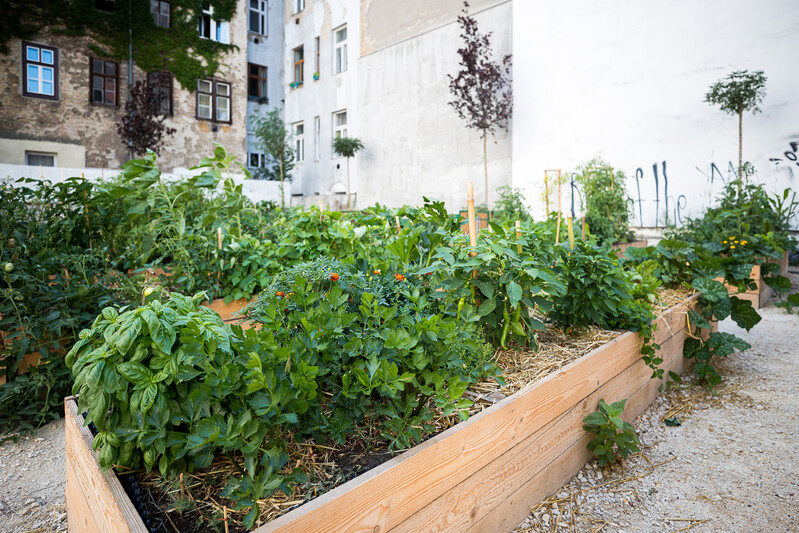
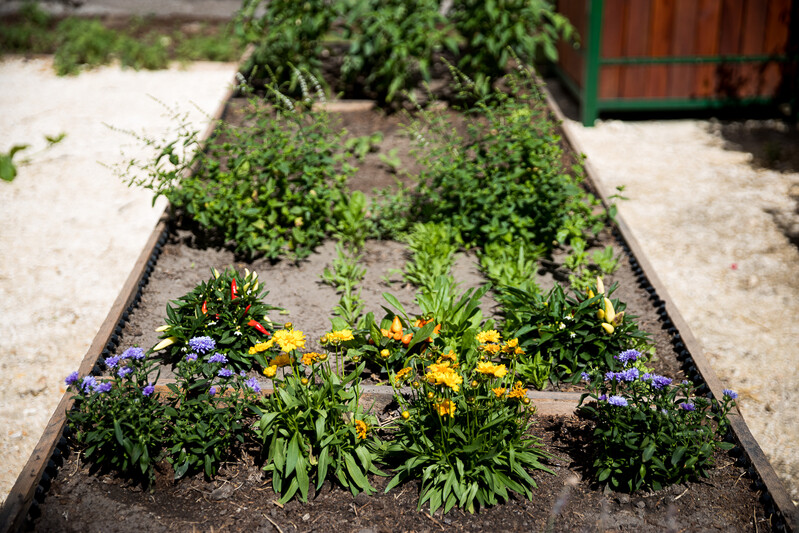
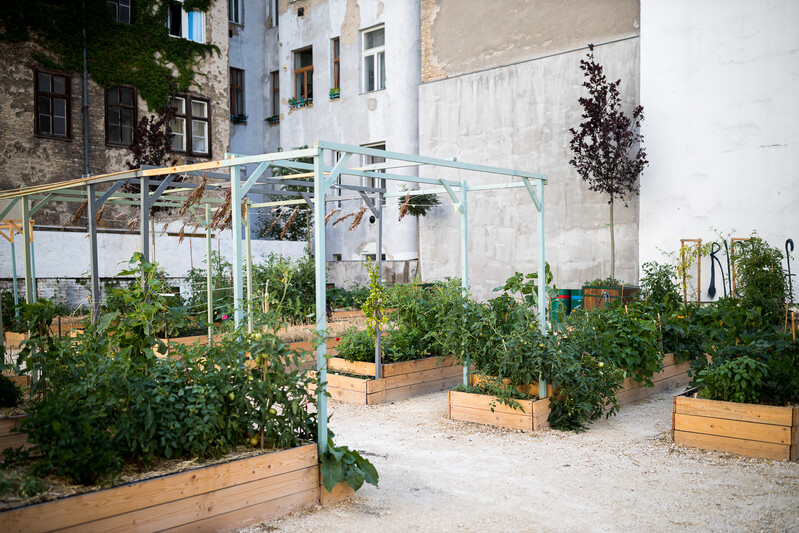
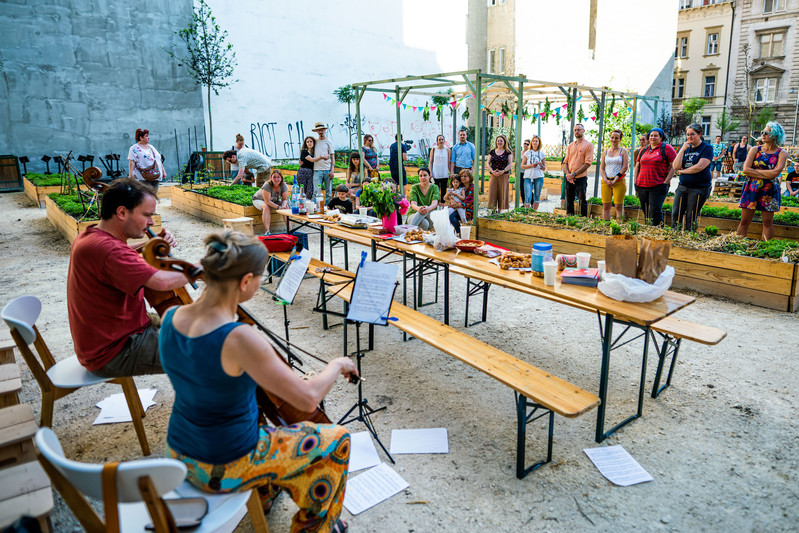
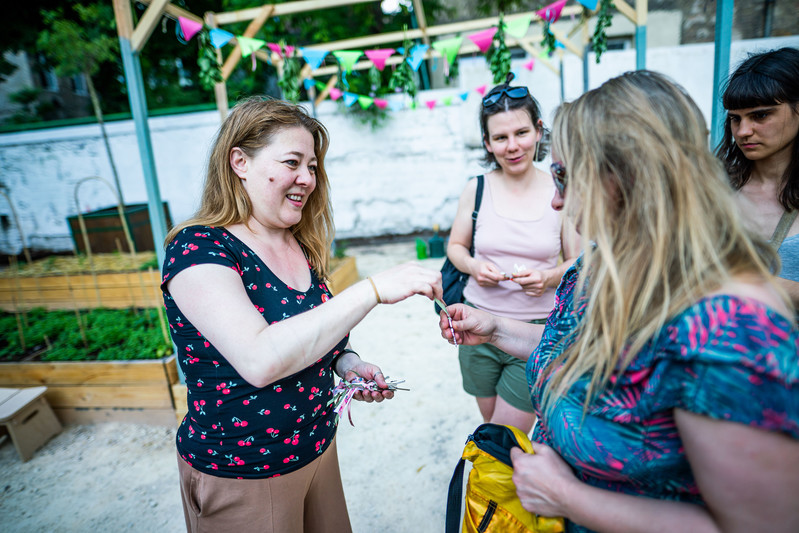
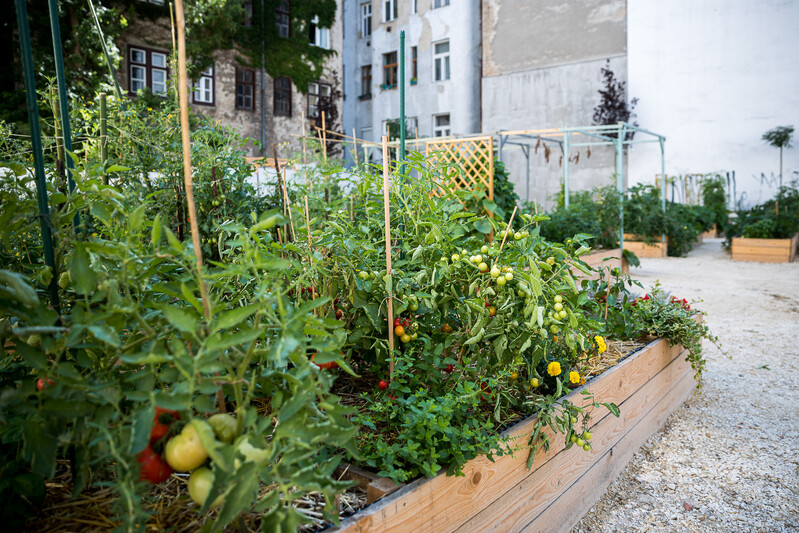
@Budapest Metropolitan Area 6th district Terézváros Municipality , 2021
Content licensed to the European Union.